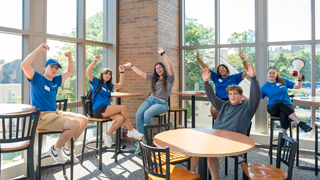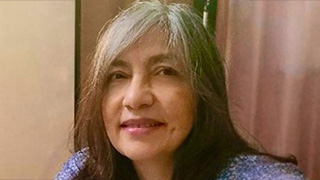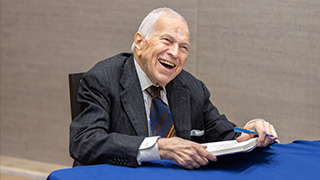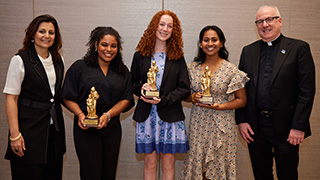School of Medicine, IHS Campus Hear Expert Talk about TB's Microbiological Battle
Friday, January 31, 2020
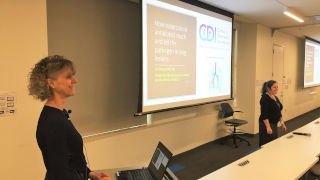
Veronique Dartois, left, presents at the IHS IPE Research Seminar Series on Jan. 24.
Tuberculosis kills more than 1.5 million people each year, mostly in the developing world. But even for those in the developed world who receive the best antibiotics available, the bacteria puts up a stubborn, nearly unyielding fight for months.
Véronique Dartois, a member of the Center for Discovery and Innovation (CDI), talked about the complex microbiological battle at the Interprofessional Health Sciences (IHS) campus – the shared campus housing Hackensack Meridian School of Medicine at Seton Hall University, and Seton Hall University's College of Nursing and School of Health and Medical Sciences – at a January 24 presentation that was part of a successful research seminar series.
The tuberculosis pathogens successfully hide themselves away in fatty deposits of the lung called caseum, an accumulation of dead immune cells that can be likened to solid abscess pus and which is cut out from drug supply through the blood. Drugs which would normally wipe out the disease are essentially blocked. It takes 6 months of daily therapy with 2 to 4 antibiotics to cure even the relatively uncomplicated, drug-susceptible cases of tuberculosis.
"Caseum is really the nightmare for TB drugs," said Dartois, in her talk at the School of Medicine.
"How Tuberculosis Antibiotics Reach and Kill the Pathogen in Lung Lesions," was part of the IHS Interprofessional Education Research Seminar Series, sponsored by the medical school, the College of Nursing, the School of Health and Medical Sciences, and the Interprofessional Health Sciences Library.
Dartois explained how she and her laboratory of CDI scientists are picking apart exactly what is happening at the level of single lesions in the lung.
By taking dissected lung tissue, then delivering the drugs directly to the germs, they are finding out why some drugs take months to help kill the tuberculosis – if they do kill the bacteria at all.
Using MALDI MSI (matrix-assisted laser desorption ionization mass spectrometry imaging), they have tested the ability of the most common TB drugs to penetrate tuberculosis lesion compartments infected with large quantities of bacteria, and whether they can even breach the fatty deposits to do their vital work in the first place.
In a growing series of publications, Dartois and her team have found that even the current regimen of three or four drugs for six months or more may not be effectively battling some strains of the TB bug.
The ultimate goal, she said, is to develop by 2024 a regimen that can cure patients in a single month.
Stan Terlecky, Ph.D., the associate dean of Research and Graduate Students, and chair of Medical Sciences at the Hackensack Meridian School of Medicine at Seton Hall University, said Dartois' expertise was a valuable addition to the seminar series.
"She is a fantastic authority in her field," said Terlecky. "She gave a terrific talk and made the presentation compelling to both experts and non-experts alike."
The IHS IPE Research Seminar Series continues on February 7 with a talk by Barry Kreiswirth, Ph.D., also a member of the Hackensack Meridian Health Center for Discovery and Innovation, who is an expert on drug-resistant germs like tuberculosis, as well as the methicillin-resistant variety of the staphylococcus bacteria, popularly known as MRSA.
For further seminars on the schedule, the schedule is here.
Categories: Health and Medicine

